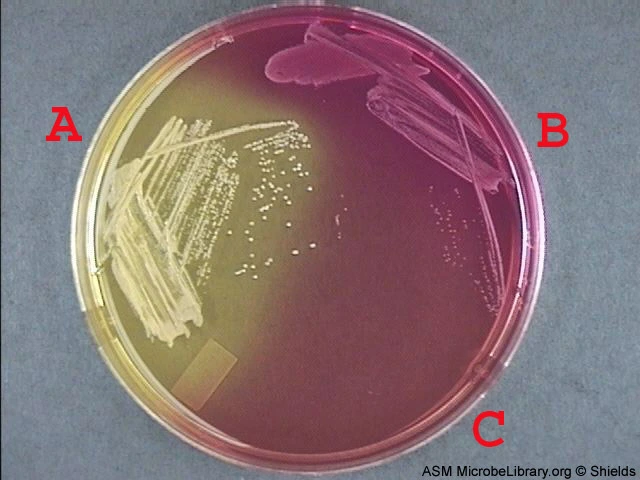Introduction
Mannitol Salt Agar (MSA) was developed in the early 20th century by microbiologist E.P. Chapman, who recognized the salt tolerance exhibited by staphylococci. Chapman incorporated high concentrations of sodium chloride into a growth medium to selectively inhibit the growth of most bacteria while allowing staphylococci to thrive. The addition of mannitol as a fermentable carbohydrate enhanced the medium’s differentiating capabilities, as the utilization of mannitol by staphylococci produced acid and resulted in a color change. Since its development, MSA has been widely used in microbiology for the isolation and identification of staphylococci.
What is Mannitol Salt Agar?
Mannitol Salt Agar (MSA) is a selective and differential culture medium used for the isolation and identification of staphylococci. This agar is named after its main components: mannitol, sodium chloride, and agar. It was initially developed by Chapman in 1945 as a medium that could selectively support the growth of staphylococci while inhibiting the growth of other microorganisms.
What is it used for?
MSA serves a dual purpose in microbiological laboratories. Firstly, it acts as a selective medium by creating an environment that is favorable for the growth of staphylococci while inhibiting the growth of other bacteria. Secondly, it serves as a differential medium by allowing microbiologists to differentiate between mannitol-fermenting and non-mannitol-fermenting bacteria based on the changes in the pH indicator present in the agar.
Principle
The functionality of Mannitol Salt Agar lies in its unique composition. Sodium chloride, present in high concentrations, creates a high osmotic environment that is inhibitory to most bacteria except staphylococci, which have adapted to withstand these conditions. Staphylococci can tolerate high salt concentrations due to their ability to synthesize compatible solutes.
Composition
The composition of Mannitol Salt Agar includes several key ingredients that contribute to its selective and differential properties. Let’s take a closer look at each component:
Mannitol
Mannitol is a sugar alcohol that serves as the fermentable carbohydrate in the medium. It provides a source of energy for mannitol-fermenting bacteria, allowing them to grow and thrive.
Sodium chloride
Sodium chloride, also known as table salt, is a critical component of MSA. It helps create a high-salt environment that selectively supports the growth of staphylococci while inhibiting the growth of other bacteria.
Phenol red
Phenol red is a pH indicator added to MSA. It starts as a red color at neutral pH (approximately pH 7.4). Changes in the pH of the medium due to bacterial metabolism can cause the color to shift, allowing for the differentiation of bacteria based on their ability to ferment mannitol.
Beef extract
Beef extract is a nutrient-rich component that provides essential vitamins and growth factors necessary for the overall growth and development of bacteria in MSA.
Peptone
peptone is a hydrolyzed protein source that provides amino acids and peptides, serving as a nutritional supplement for bacterial growth.
| Ingredients | gram / liter |
| Mannitol | 10g |
| Beef meat extract | 1 g |
| Sodium chloride | 75g |
| Peptone | 10 g |
| Phenol red | 0.025g |
| Agar | 15g |
| pH final | 7,4 ± 0,2 |
Preparation
The preparation of Mannitol Salt Agar involves several steps to ensure the proper incorporation of ingredients and the sterility of the medium. Here is a brief outline of the preparation process:
Dissolve the ingredients in water:
The first step in preparing MSA is to dissolve the appropriate amounts of mannitol, sodium chloride, phenol red, beef extract, and peptone in distilled water. The concentrations of these ingredients may vary depending on the specific formulation or manufacturer’s instructions.
Autoclave the medium:
After thorough mixing, the medium is sterilized by autoclaving. Autoclaving involves subjecting the medium to high-pressure steam, which effectively kills any present microorganisms and ensures sterility.
Pour the medium into plates:
Once the medium has been autoclaved, it is poured into sterile Petri dishes and allowed to solidify. This process creates a solid surface suitable for bacterial growth.

Interpretation of Results
The interpretation of results obtained from Mannitol Salt Agar is crucial for identifying different bacterial species. Here are the key interpretations based on colony appearance:
Yellow colonies: Mannitol-fermenting bacteria
Bacteria capable of fermenting mannitol produce acid as a byproduct, leading to a drop in pH. This acidification causes the phenol red indicator to shift from red to yellow, resulting in the formation of yellow colonies.
Red colonies: Non-mannitol-fermenting bacteria
Bacteria that do not ferment mannitol do not produce acid, and therefore, the medium’s pH remains neutral. Consequently, the colonies appear red, indicating their inability to utilize mannitol.
Growth of Bacteria
Mannitol Salt Agar supports the growth of various bacteria, but certain species exhibit distinct characteristics on this medium. Let’s explore two significant bacterial species commonly observed on MSA:
Staphylococcus aureus
Staphylococcus aureus, a pathogenic bacterium, is one of the most prominent organisms that can grow on MSA. This bacterium ferments mannitol, leading to a distinct change in the medium’s pH indicator, phenol red.
Staphylococcus epidermidis:
- Staphylococcus epidermidis, a normal flora bacterium found on human skin, is another species that can grow on MSA. However, unlike Staphylococcus aureus, it does not ferment mannitol, resulting in a different observable phenotype.
Other Bacteria
While MSA is primarily designed to facilitate the growth of staphylococci, it is important to note that other bacteria can also grow on this medium. Some examples include micrococci, which are closely related to staphylococci, and certain halophilic bacteria that can tolerate high salt concentrations.
Applications
The applications of Mannitol Salt Agar extend beyond the isolation and identification of staphylococci. Here are some notable applications in the field of microbiology:
Isolation of staphylococci
MSA’s selective properties make it an excellent medium for the isolation of staphylococci from clinical specimens, such as wound swabs or nasal samples. It provides a favorable environment for the growth of staphylococci while inhibiting the growth of other microorganisms.
Identification of staphylococci
The ability of MSA to differentiate between mannitol-fermenting and non-mannitol-fermenting bacteria aids in the identification of staphylococci, particularly in distinguishing Staphylococcus aureus from other species.
Sensitivity testing of staphylococci:
Mannitol Salt Agar can also be used to perform sensitivity testing or antimicrobial susceptibility testing on staphylococci. By incorporating antibiotics into the agar, researchers can determine the effectiveness of specific antimicrobial agents against the isolated bacteria.
Limitations
While Mannitol Salt Agar is a valuable tool in the microbiologist’s arsenal, it does have certain limitations that need to be considered:
Not all staphylococci are mannitol-fermenting:
Although most Staphylococcus aureus strains are mannitol-fermenting, a small percentage may exhibit atypical or variant reactions. This can lead to potential misidentification or false-negative results.
Other bacteria can grow on MSA:
Despite its selective properties, MSA is not entirely specific to staphylococci. Some microorganisms, such as micrococci and halophilic bacteria, can tolerate the high salt concentrations and also grow on this medium. Therefore, additional confirmatory tests are necessary to accurately identify specific bacterial species.
Conclusion
In conclusion, Mannitol Salt Agar is a valuable and versatile tool in the field of microbiology. Its selective and differential properties allow for the isolation, identification, and sensitivity testing of staphylococci. While it has its limitations, proper utilization and interpretation of results can provide valuable insights into the presence and characteristics of specific bacterial species. Microbiologists continue to rely on Mannitol Salt Agar as an essential component of their laboratory work, contributing to advancements in diagnostics, research, and patient care.
References
- Tortora, G. J., Funke, B. R., & Case, C. L. (2021). Microbiology: An introduction. Pearson Education Limited.
Atlas, R. M. (2010). Handbook of Microbiological Media. CRC Press. - Mannitol Salt Agar (MSA) (Chapman Medium) European Pharmacopoeia, Usp.
- Hardy Diagnostics.
- Mannitol Salt Agar. Dehydrated Culture Media. Thermo Fisher Scientific Inc.
- https://en.wikipedia.org/wiki/Mannitol_salt_agar





